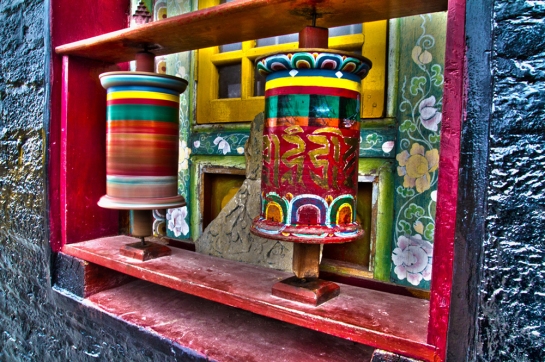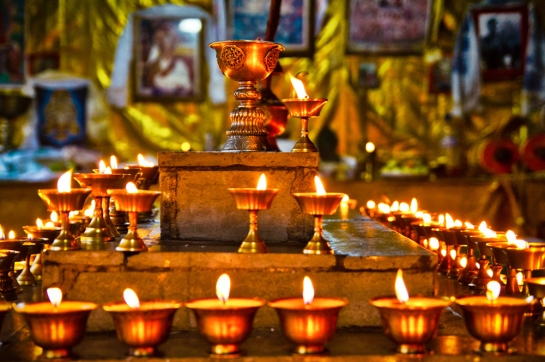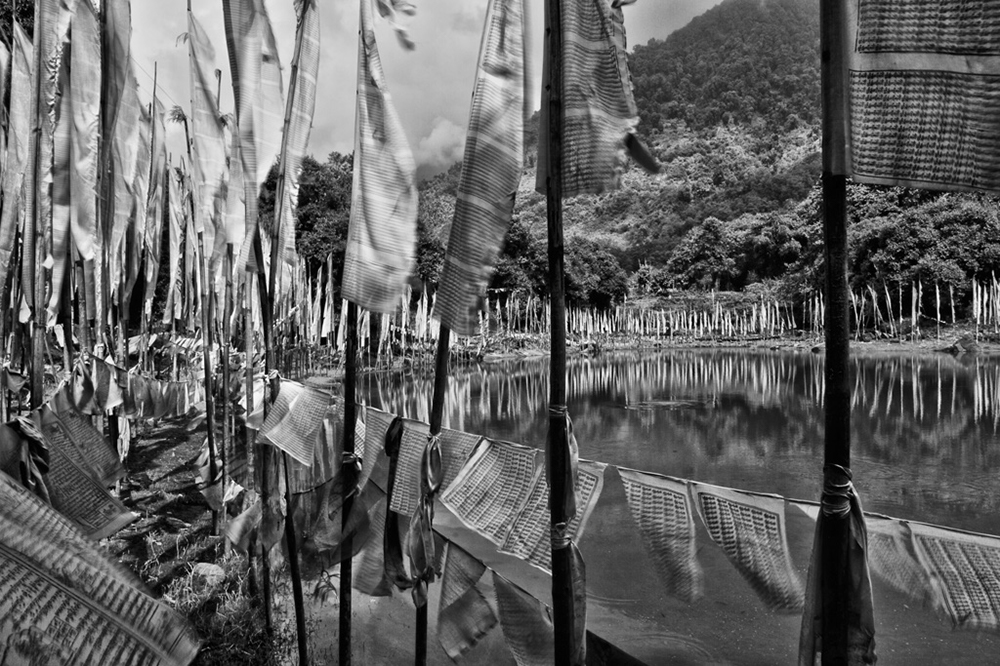
Prayer Wheels (Pelling, India)
Prayer wheels along the outer wall of a small gompa in Pelling.

Prayer Wheels (Pelling, India)
Prayer wheels along the outer wall of a small gompa in Pelling.

Durga Idols (Kolkata, India)
Clay idols at various stages in the process of being finalized as part of the huge annual Durga Festival in Kolkata.

Khecheopari Bells (Sikkim, India)
Bells, like the prayer flags, prayer wheels and mani stones, are used by the tibetan buddhists to spread their prayers of compassion, wisdom and peace. It is believed that when the wind blows and the bells ring, the sound of the bells spread the prayers into all pervading space for the benefit of all. ..wish I could stay here a little longer than planned.
…

Sangachoeling Monk (Sikkim, India)
Sangachoeling Gompa is a small, very old monastery that sits on a ridge near the town of Pelling. It’s home to probably a dozen or so monks. I came across it during an early morning stroll through the mountains. There weren’t any other visitors and their supporters seemed modest in both numbers and means. This fellow blew the conch shell as they circumambulated a stupa before their mid-morning meal.
…

Sikkim Prayer Flags (Sikkim, India)
Traditionally, prayer flags are used to promote peace, compassion, strength, and wisdom. The flags do not carry prayers to gods, a common misconception; rather, buddhists believe the prayers and mantras will be blown by the wind to spread the good will and compassion into all pervading space. Therefore, prayer flags are thought to bring benefit to all.
…

Butter Lamps (Yuksom, India)
These butter lamps are kept burning 24/7 in a small little hut on the shores of Khecheopalri Lake off the road between Pelling and Yuksom.
Khecheopalri Lake, originally known as Kha-Chot-Palri, is a sacred Lake for both Buddhists and Hindus, which is believed to be a wish fulfilling lake.

Pemayangtse Window (Sikkim, India)
We’re not allowed to take photos inside the buddhist gompas but trust me, they are incredibly colorful and stunningly beautiful. You can catch a peak of the inside by standing outside shooting in, which I did, but I like the simplicity of this shot. Those are ‘mani’ stones on the window ledge – the monks carve prayers and mantras, the most common of which is ‘om mani padme hum’ (hence the name ‘mani’ stones) into the stones as a means of meditation.

Kathok Wodsallin Gompa (Sikkim, India)
The tiny Kathok Wodsallin Gompa in the town of Yuksom didn’t appear to have any resident monks, other than the temple keeper. It sits on a small knoll overlooking the village below. The circle staircase to the upper level is an unusual sight for me – not sure I’ve ever seen that in a gompa before…the colors, however, are such a wonderful reflection of the tibetan buddhist tradition of brightly painted buildings and statues and tankhas…

Yuksom Girl (Yuksom, India)
This young girl was shy but playful. I met her at a small roadside stand in Yuksom, where her mother was selling vegetables.

Yuksom Yaks (Sikkim, India)
Yeah, these old yaks have probably moved a few mountains worth of gear up and down these hills since trekking is the activity of choice in this area and these fellows are a central part of that. I think they deserve a day off…or maybe few….
Kathakali is a form of highly stylised classical Indian dance-drama that blends literature, music, painting, acting and dance. It originated in the country’s southern state of Kerala during the 16th century AD, approximately between 1555 and 1605.
There is no dialogue in Kathakali. Instead, communication among the characters, and to the audience, is through an intricate language of hand gestures, combined with facial expression and body movements.
The make-up, called Chutty, is an art form in itself. The colourful faces are the results of hours of painstaking handiwork by expert artists. The basic materials used for the make up are very crude items like raw amorphous Sulphur, Indigo, Rice paste, Lime, Coconut oil etc. It can take up to 6 hours to prepare a performer’s make-up.

Kathok Lake (Yuksom, India)
This quiet little lake near Yuksom village is chock full of prayer flags. I was supposed to head east and then north east to Bumthang valley a few days ago but there was a bad earthquake in late September which has made the roads impassable (as it was, the roads getting here were, at times, very rugged b/c of landslides from the monsoons). So I’ve been hanging out in west Sikkim in a few villages that are really jumping off points for treks into the higher elevation mountains.

Sanghachoeline Monestary (Pelling, India)
A group of young novices pose for a shot with a young woman who serves as their cook, monastery keeper and caretaker at Sanghachoeling Monestary, near the town of Pelling.

Garlic and Potatos
I was originally attracted to this guy’s halter bra, but after chatting with him, he charmed me with his quick wit and gentle spirit.

Street Sleeping (Kolkata, India)
An unfortunate part of the reality that is Kolkata. Some days, it seems I couldn’t take more than a few steps without having to walk by or around men, women, children or entire families sleeping on the sidewalks and along the streets of the city.